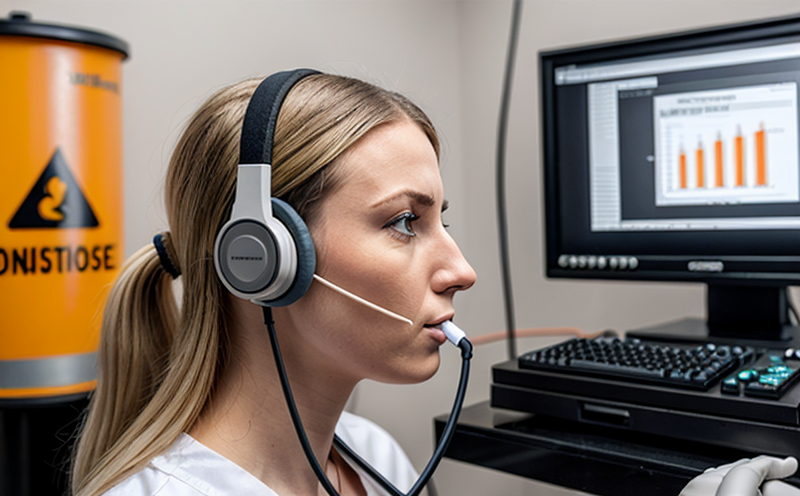ISO 11205 Hand-Held Sound Level Meter Testing for Workplaces
The ISO 11205 standard is a cornerstone in occupational health and safety, particularly when it comes to assessing noise levels in the workplace. This international standard specifies procedures for calibrating and testing hand-held sound level meters (SLMs) used to measure ambient noise exposure. Compliance with this standard ensures that the SLMs are accurate and reliable, which is crucial for effective monitoring of occupational noise levels.
Occupational noise-induced hearing loss is a significant concern globally. According to the World Health Organization (WHO), about 16% of the global burden of deafness and hearing impairment is attributed to occupational noise exposure. To mitigate this risk, employers are required by law in many countries to measure and control workplace noise levels. This testing ensures that the SLMs used for these measurements meet the stringent requirements set forth by ISO.
The process involves several key steps. Initially, the SLM must be calibrated against a primary standard or reference sound level meter. After calibration, it undergoes rigorous testing in controlled environments to ensure its accuracy and stability over time. The testing includes various frequency ranges and sound pressure levels that are representative of real-world workplace conditions. This ensures that the instrument can accurately measure noise levels across the spectrum relevant to occupational health.
Accuracy is paramount when measuring noise levels, as even small errors in measurement can lead to significant misinterpretations of exposure levels. The ISO 11205 standard provides clear guidelines on how to perform these tests, ensuring that all stakeholders have a consistent and reliable method for assessing noise exposure. This standardization not only enhances the accuracy but also promotes comparability between different measurements taken by various SLMs.
The testing process typically involves placing the SLM in specified locations within the workplace, where it records sound levels over a set period. The data collected is then analyzed to determine compliance with local and international noise exposure limits. Compliance with these standards helps protect workers from potential hearing damage and other health risks associated with excessive noise.
Furthermore, this testing ensures that employers are fulfilling their legal obligations under various occupational safety regulations. For instance, in the European Union, Directive 2003/10/EC on the protection of workers from the risks related to exposure to physical agents (noise) sets specific limits for different types of work environments. Employers who use ISO-compliant SLMs can be confident that their measurements are accurate and reliable, thereby ensuring compliance with these directives.
The importance of this testing cannot be overstated. It is a critical component in the broader strategy of occupational health management, aimed at protecting workers from noise-induced hearing loss and other related health issues. By adhering to the ISO 11205 standard, employers not only meet regulatory requirements but also demonstrate their commitment to worker safety and well-being.
Environmental and Sustainability Contributions:
The accurate measurement of workplace noise levels ensures that protective measures are implemented effectively, reducing unnecessary exposure to harmful noise.
This reduces the incidence of occupational hearing loss, which is a significant contributor to healthcare costs and decreased productivity in affected workers.
By promoting the use of reliable SLMs, this standard contributes to overall environmental sustainability by fostering safer work environments that minimize risks to both employees and the broader community.
EuroLab offers a comprehensive suite of services designed to meet the highest standards in occupational noise exposure testing. Our team of experts ensures that every aspect of your project is handled with precision and professionalism, from initial consultation to final reporting.
We provide tailored solutions for various industries, including manufacturing, construction, and healthcare, ensuring that our clients receive bespoke services that address their unique needs. Our state-of-the-art facilities are equipped with the latest technology, allowing us to conduct accurate and reliable tests in a wide range of environments.
Our commitment to excellence is reflected in our certifications and accreditations, which include ISO/IEC 17025 for laboratory testing services. This certification ensures that our processes meet international standards for accuracy, precision, and reliability. Our team of qualified professionals undergo continuous training to stay abreast of the latest developments in acoustics and vibration technology.
At EuroLab, we understand the importance of timely delivery and excellent service. We strive to provide prompt responses to inquiries and deliver reports within agreed-upon timelines. Our clients can expect reliable communication throughout the project, ensuring that they are kept informed at every stage.
International Acceptance and Recognition
The ISO 11205 standard is widely recognized and accepted across numerous countries due to its rigorous testing protocols and emphasis on accuracy. Many nations have adopted this standard as a benchmark for occupational noise exposure testing, reflecting the global consensus on the importance of reliable noise measurement instruments.
For instance, in Europe, the European Union's Occupational Safety and Health (OSH) framework explicitly references ISO 11205 as part of its efforts to harmonize national regulations. Similarly, countries like the United States, Canada, and Australia have incorporated this standard into their occupational health and safety laws.
The widespread acceptance of ISO 11205 is not limited to regulatory compliance but extends to the broader scientific community and industry stakeholders. Many leading acoustics research institutions and manufacturers use this standard as a reference for developing new technologies and methodologies in noise measurement.
Recognizing its global significance, organizations such as the International Organization for Standardization (ISO) regularly review and update the standard to ensure it remains relevant and effective. This ongoing process ensures that ISO 11205 continues to set the gold standard for occupational noise exposure testing worldwide.





